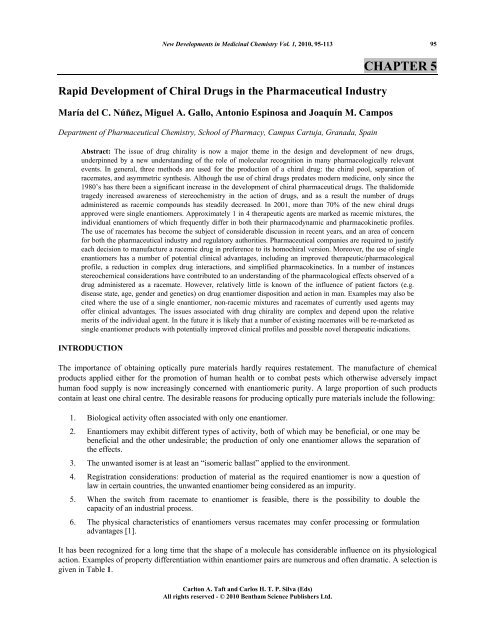chapter 1 - Bentham Science
chapter 1 - Bentham Science
chapter 1 - Bentham Science
You also want an ePaper? Increase the reach of your titles
YUMPU automatically turns print PDFs into web optimized ePapers that Google loves.
New Developments in Medicinal Chemistry Vol. 1, 2010, 95-113 95<br />
Rapid Development of Chiral Drugs in the Pharmaceutical Industry<br />
María del C. Núñez, Miguel A. Gallo, Antonio Espinosa and Joaquín M. Campos<br />
Department of Pharmaceutical Chemistry, School of Pharmacy, Campus Cartuja, Granada, Spain<br />
Carlton A. Taft and Carlos H. T. P. Silva (Eds)<br />
All rights reserved - © 2010 <strong>Bentham</strong> <strong>Science</strong> Publishers Ltd.<br />
CHAPTER 5<br />
Abstract: The issue of drug chirality is now a major theme in the design and development of new drugs,<br />
underpinned by a new understanding of the role of molecular recognition in many pharmacologically relevant<br />
events. In general, three methods are used for the production of a chiral drug: the chiral pool, separation of<br />
racemates, and asymmetric synthesis. Although the use of chiral drugs predates modern medicine, only since the<br />
1980’s has there been a significant increase in the development of chiral pharmaceutical drugs. The thalidomide<br />
tragedy increased awareness of stereochemistry in the action of drugs, and as a result the number of drugs<br />
administered as racemic compounds has steadily decreased. In 2001, more than 70% of the new chiral drugs<br />
approved were single enantiomers. Approximately 1 in 4 therapeutic agents are marked as racemic mixtures, the<br />
individual enantiomers of which frequently differ in both their pharmacodynamic and pharmacokinetic profiles.<br />
The use of racemates has become the subject of considerable discussion in recent years, and an area of concern<br />
for both the pharmaceutical industry and regulatory authorities. Pharmaceutical companies are required to justify<br />
each decision to manufacture a racemic drug in preference to its homochiral version. Moreover, the use of single<br />
enantiomers has a number of potential clinical advantages, including an improved therapeutic/pharmacological<br />
profile, a reduction in complex drug interactions, and simplified pharmacokinetics. In a number of instances<br />
stereochemical considerations have contributed to an understanding of the pharmacological effects observed of a<br />
drug administered as a racemate. However, relatively little is known of the influence of patient factors (e.g.<br />
disease state, age, gender and genetics) on drug enantiomer disposition and action in man. Examples may also be<br />
cited where the use of a single enantiomer, non-racemic mixtures and racemates of currently used agents may<br />
offer clinical advantages. The issues associated with drug chirality are complex and depend upon the relative<br />
merits of the individual agent. In the future it is likely that a number of existing racemates will be re-marketed as<br />
single enantiomer products with potentially improved clinical profiles and possible novel therapeutic indications.<br />
INTRODUCTION<br />
The importance of obtaining optically pure materials hardly requires restatement. The manufacture of chemical<br />
products applied either for the promotion of human health or to combat pests which otherwise adversely impact<br />
human food supply is now increasingly concerned with enantiomeric purity. A large proportion of such products<br />
contain at least one chiral centre. The desirable reasons for producing optically pure materials include the following:<br />
1. Biological activity often associated with only one enantiomer.<br />
2. Enantiomers may exhibit different types of activity, both of which may be beneficial, or one may be<br />
beneficial and the other undesirable; the production of only one enantiomer allows the separation of<br />
the effects.<br />
3. The unwanted isomer is at least an “isomeric ballast” applied to the environment.<br />
4. Registration considerations: production of material as the required enantiomer is now a question of<br />
law in certain countries, the unwanted enantiomer being considered as an impurity.<br />
5. When the switch from racemate to enantiomer is feasible, there is the possibility to double the<br />
capacity of an industrial process.<br />
6. The physical characteristics of enantiomers versus racemates may confer processing or formulation<br />
advantages [1].<br />
It has been recognized for a long time that the shape of a molecule has considerable influence on its physiological<br />
action. Examples of property differentiation within enantiomer pairs are numerous and often dramatic. A selection is<br />
given in Table 1.

















